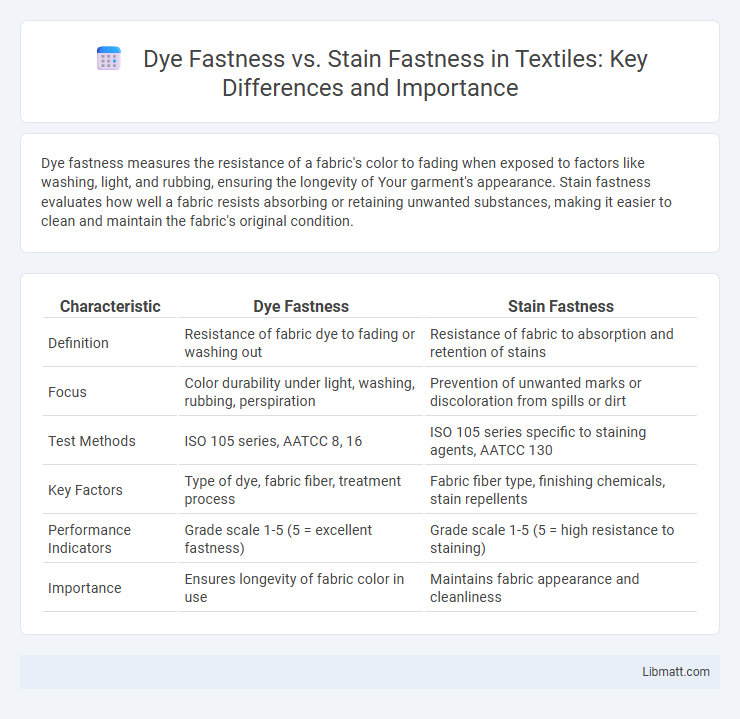Dye fastness measures the resistance of a fabric's color to fading when exposed to factors like washing, light, and rubbing, ensuring the longevity of Your garment's appearance. Stain fastness evaluates how well a fabric resists absorbing or retaining unwanted substances, making it easier to clean and maintain the fabric's original condition.
Table of Comparison
| Characteristic | Dye Fastness | Stain Fastness |
|---|---|---|
| Definition | Resistance of fabric dye to fading or washing out | Resistance of fabric to absorption and retention of stains |
| Focus | Color durability under light, washing, rubbing, perspiration | Prevention of unwanted marks or discoloration from spills or dirt |
| Test Methods | ISO 105 series, AATCC 8, 16 | ISO 105 series specific to staining agents, AATCC 130 |
| Key Factors | Type of dye, fabric fiber, treatment process | Fabric fiber type, finishing chemicals, stain repellents |
| Performance Indicators | Grade scale 1-5 (5 = excellent fastness) | Grade scale 1-5 (5 = high resistance to staining) |
| Importance | Ensures longevity of fabric color in use | Maintains fabric appearance and cleanliness |
Understanding Dye Fastness: Definition and Importance
Dye fastness refers to the resistance of a textile's color to fading or running when exposed to environmental factors such as washing, light, rubbing, and perspiration. It is a critical property that determines the durability and longevity of dyed fabrics in various applications, ensuring consistent appearance and quality. High dye fastness helps prevent color deterioration, maintaining the fabric's aesthetic appeal and consumer satisfaction over time.
What Is Stain Fastness? Core Concepts Explained
Stain fastness refers to the resistance of a fabric or material to absorb or retain unwanted substances such as dirt, oils, or liquids, preventing visible marks or discoloration. It is a critical property in textiles, indicating how well a material can repel or resist stains during exposure to various staining agents. High stain fastness enhances the durability and aesthetic longevity of fabrics, reducing the need for frequent cleaning or replacement.
Key Differences Between Dye Fastness and Stain Fastness
Dye fastness refers to the resistance of a fabric's color to fading or running when exposed to light, washing, or rubbing, while stain fastness measures how well a fabric resists absorption and removal of foreign substances like food or dirt. Your choice between dye fastness and stain fastness depends on whether you prioritize long-lasting color retention or ease of cleaning from accidental spills. Understanding these distinct properties ensures you select textiles that match your durability and maintenance needs.
Factors Affecting Dye Fastness in Textiles
Dye fastness in textiles is influenced by factors such as fiber type, dye class, and fixation method, which determine the dye's resistance to washing, light, and rubbing. Chemical properties of dyes, including molecular size and affinity to fibers, affect their binding strength and durability on fabric surfaces. Environmental conditions during dyeing and post-treatment processes, like temperature and pH, also play critical roles in ensuring long-lasting color retention.
Common Causes of Poor Stain Fastness
Poor stain fastness commonly results from exposure to oily substances, acidic or alkaline chemicals, and improper washing techniques that fail to remove stains effectively. Fabric type and dye chemistry also influence stain resistance, with synthetic fibers often exhibiting different retention properties compared to natural fibers. Ensuring your garments have enhanced stain fastness requires selecting appropriate treatments or finishes that repel common contaminants and facilitate easier cleaning.
Testing Methods for Dye Fastness
Testing methods for dye fastness primarily include exposure to light, washing, rubbing, and perspiration to evaluate color durability under various conditions. Standardized tests like ISO 105 and AATCC 61 simulate real-life aging and usage scenarios to measure how well dyes resist fading or bleeding. Your fabric's longevity and appearance depend heavily on these rigorous assessments to ensure high-quality dye retention.
How Stain Fastness Is Assessed and Rated
Stain fastness is assessed by exposing textiles to common staining agents such as food, oils, or inks, then measuring the degree of stain absorption or resistance using standardized testing methods like ISO 105 or AATCC tests. Ratings range from 1 to 5, with 5 indicating excellent stain resistance and minimal discoloration, which helps you understand how well fabrics maintain their appearance under everyday conditions. This assessment is crucial for comparing performance between dye fastness, which measures color retention against fading, and stain fastness, which evaluates fabric's ability to resist unwanted marks.
Practical Applications: Dye vs Stain Fastness in Daily Use
Dye fastness refers to the resistance of fabric colors to fading or running from exposure to washing, sunlight, and perspiration, making it essential for maintaining garment appearance over multiple wears. Stain fastness measures how well a material resists or releases stains from substances like food, oils, or dirt, influencing the ease of cleaning in everyday situations. Practical applications highlight that clothing with high dye fastness retains vibrancy, while high stain fastness ensures fabrics remain clean and stain-free with minimal maintenance.
Improving Dye and Stain Fastness: Tips and Techniques
Improving dye fastness involves selecting high-quality reactive or vat dyes combined with proper fabric pretreatment, such as thorough scouring and mordant application, to enhance dye-fiber bonding and color durability. Enhancing stain fastness requires applying advanced stain repellents, using hydrophobic finishes, and incorporating enzyme treatments to break down stain-causing molecules on textile surfaces. Utilizing optimized dye-fixation processes like steaming or curing, alongside regular washing with appropriate detergents, further boosts both dye and stain fastness in textiles.
Choosing Fabrics: Prioritizing Dye or Stain Fastness
When choosing fabrics, prioritize dye fastness to ensure colors remain vibrant and resistant to fading from washing, sunlight, and abrasion. Stain fastness is critical for materials exposed to frequent spills or dirt, offering resistance to penetration and ease of cleaning. Selecting fabrics with both high dye and stain fastness enhances durability and maintains aesthetic appeal in everyday use.
Dye fastness vs Stain fastness Infographic

 libmatt.com
libmatt.com